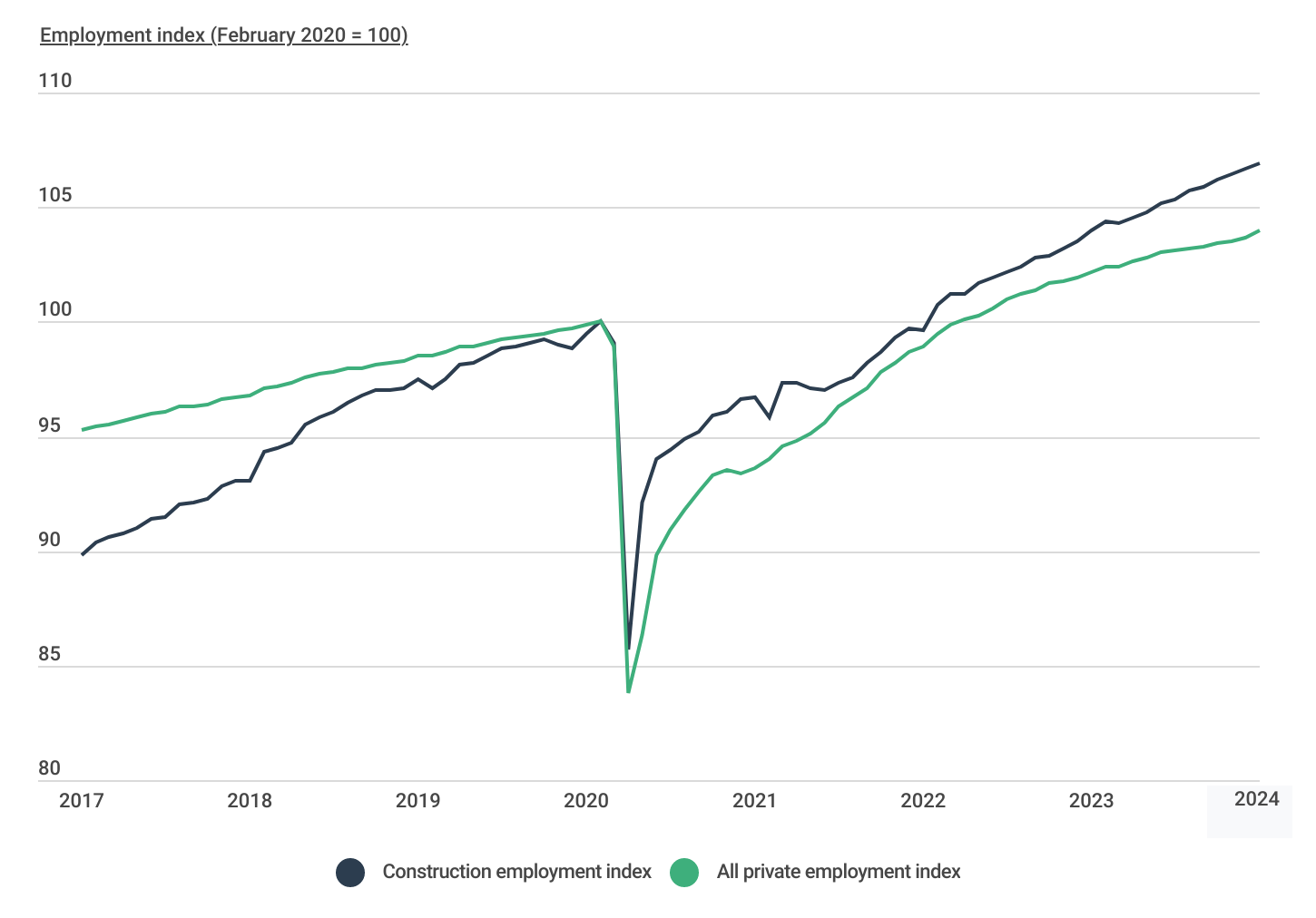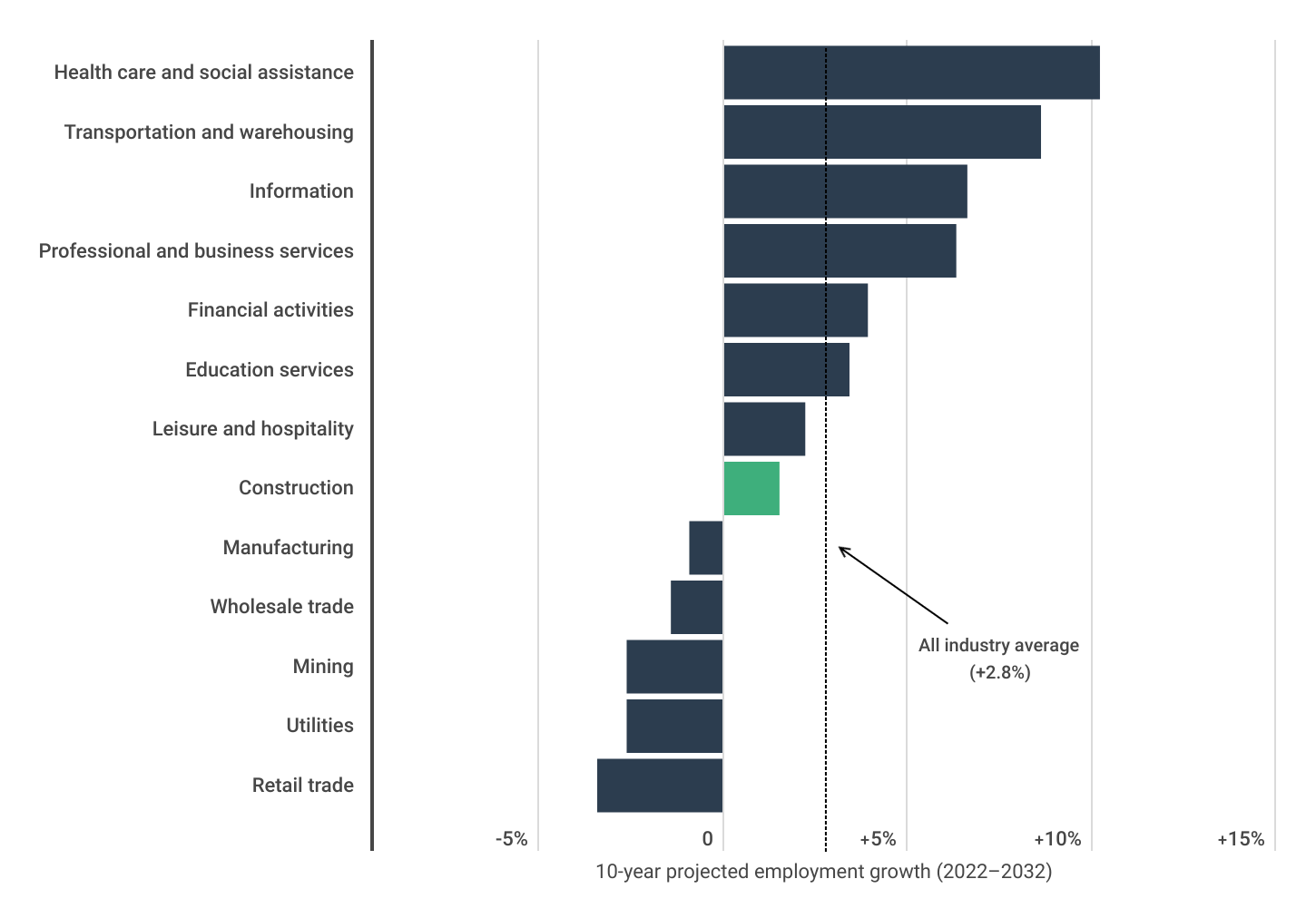The Fastest-Growing Jobs in Construction
Note: This is the most recent release of our Fastest-Growing Jobs in Construction study. To see data from prior years, please visit the Full Results section below.
Despite recent inflation, high interest rates, and persistent recession fears, the outlook for the construction industry in the next few years appears positive.
A January 2024 report from the American Institute of Architects projects a 4% growth in nonresidential construction in 2024 after already increasing an impressive 22% in 2023. Residential construction experienced dramatic declines in 2022 as rising costs mounted, but these declines came off of record-high activity the prior two years, and more recently, privately-owned housing permits increased by 8.6% year-over-year in January. With the industry also experiencing a workforce shortage, job growth in construction is projected to be steady.
High demand for construction across the board has helped boost the industry over the past three years, and could help construction companies weather a potential recession. The dramatic run-up in home values and rents highlighted the need to add residential housing supply, while the federal government has also been investing heavily in construction and infrastructure in recent years. A series of COVID-19 relief packages in 2020 and 2021 has sent billions of dollars flowing to the industry, but the centerpiece of federal investment was a $1.9 trillion infrastructure bill signed into law in late 2021. The bipartisan package will fund major new construction projects in transportation, telecommunication, energy, and more for years to come.
Changes in Construction Employment Over Time
The construction industry recovered faster from the COVID-19 recession than other sectors

Heightened demand and investment in the construction industry has translated to strong employment numbers. Construction was not as hard-hit as other parts of the economy by mass layoffs at the outset of the COVID-19 pandemic, and the industry also recovered jobs more quickly. Construction employment had a strong bounceback after lockdowns and other restrictions began to ease in the late spring of 2020, and has continued to grow since then. Notably, employment in the industry passed pre-pandemic levels in February 2022, three months before the economy as a whole hit the same milestone.
RELATED
As software and technology have transformed the construction industry, the construction management role has changed dramatically. Construction managers now spend much of their time using dedicated software products—like construction management software—to perform a wide range of tasks at scale.
Employment Growth Projections by Industry
Overall, employment in the construction industry is projected to grow slower than average over the next decade

In part because of the construction industry’s faster COVID-19 recovery, the Bureau of Labor Statistics estimates that job growth in the construction industry will be slower than average over the next decade. Construction employment is projected to grow just 1.5% from 2022 to 2032, compared to an average 2.8% rate of job growth across all industries. Another reason for below-average projected growth is that technological changes in the industry are poised to make many processes more efficient and less labor-intensive, which will in turn change the composition of jobs in the industry.
Because of this, as the industry changes and modernizes, many of the professions set for the greatest rate of growth are in fact jobs not commonly associated with construction. For example, demand for market research analysts, software developers, logisticians, and financial managers in the construction sector is projected to be robust in the coming years. But construction industry jobs with the greatest projected growth rates are related to renewable energy—including wind and solar.
Below is a complete breakdown of the fastest-growing jobs in the construction industry across over 190 occupations. The analysis was conducted by researchers at Construction Coverage using the latest data from the U.S. Bureau of Labor Statistics. For more information on how each metric was calculated, refer to the methodology section below.
The Fastest-Growing Construction Industry Jobs

Photo Credit: David Gyung / Shutterstock
15. Market research analysts and marketing specialists
- 10-year projected employment growth (percent): +8.0%
- 10-year projected employment growth (total): +1,300
- Total employment (current): 16,300
- Median annual wage (current): $59,270
RELATED
Software companies like Procore, Sage, and CMiC have transformed the construction industry in recent years by automating processes that used to require hours of manual work. Outside of construction management software, some of the most noteworthy new product categories include takeoff, estimating, construction accounting, and field service management software.

Photo Credit: Varavin88 / Shutterstock
14. Electricians
- 10-year projected employment growth (percent): +8.5%
- 10-year projected employment growth (total): +46,400
- Total employment (current): 544,500
- Median annual wage (current): $59,300

Photo Credit: PongMoji / Shutterstock
13. Telecommunications line installers and repairers
- 10-year projected employment growth (percent): +9.3%
- 10-year projected employment growth (total): +2,900
- Total employment (current): 31,500
- Median annual wage (current): $47,840

Photo Credit: BigPixel Photo / Shutterstock
12. Mechanical engineers
- 10-year projected employment growth (percent): +9.9%
- 10-year projected employment growth (total): +400
- Total employment (current): 4,400
- Median annual wage (current): $81,380

Photo Credit: ndoeljindoel / Shutterstock
11. Industrial engineers
- 10-year projected employment growth (percent): +10.3%
- 10-year projected employment growth (total): +200
- Total employment (current): 1,800
- Median annual wage (current): $82,160

Photo Credit: Elizaveta Galitckaia / Shutterstock
10. Floor layers, except carpet, wood, and hard tiles
- 10-year projected employment growth (percent): +10.6%
- 10-year projected employment growth (total): +1,800
- Total employment (current): 17,200
- Median annual wage (current): $48,110

Photo Credit: Martin Dworschak / Shutterstock
9. Tile and stone setters
- 10-year projected employment growth (percent): +10.6%
- 10-year projected employment growth (total): +3,600
- Total employment (current): 34,000
- Median annual wage (current): $49,340

Photo Credit: wutzkohphoto / Shutterstock
8. Financial managers
- 10-year projected employment growth (percent): +10.9%
- 10-year projected employment growth (total): +1,900
- Total employment (current): 17,500
- Median annual wage (current): $129,750

Photo Credit: APChanel / Shutterstock
7. Occupational health and safety specialists
- 10-year projected employment growth (percent): +11.9%
- 10-year projected employment growth (total): +1,900
- Total employment (current): 15,600
- Median annual wage (current): $78,060

Photo Credit: Kzenon / Shutterstock
6. Logisticians
- 10-year projected employment growth (percent): +12.1%
- 10-year projected employment growth (total): +200
- Total employment (current): 2,000
- Median annual wage (current): $70,490

Photo Credit: Andrey Popov / Shutterstock
5. Mechanical door repairers
- 10-year projected employment growth (percent): +12.5%
- 10-year projected employment growth (total): +2,500
- Total employment (current): 20,200
- Median annual wage (current): $47,530

Photo Credit: Zakhar Mar / Shutterstock
4. Radio, cellular, and tower equipment installers and repairers
- 10-year projected employment growth (percent): +13.6%
- 10-year projected employment growth (total): +300
- Total employment (current): 2,300
- Median annual wage (current): $50,020

Photo Credit: wutzkohphoto / Shutterstock
3. Software developers
- 10-year projected employment growth (percent): +14.0%
- 10-year projected employment growth (total): +400
- Total employment (current): 2,600
- Median annual wage (current): $100,220

Photo Credit: Anatoliy Gleb / Shutterstock
2. Solar photovoltaic installers
- 10-year projected employment growth (percent): +29.0%
- 10-year projected employment growth (total): +4,800
- Total employment (current): 16,500
- Median annual wage (current): $48,270

Photo Credit: Aunging / Shutterstock
1. Wind turbine service technicians
- 10-year projected employment growth (percent): +50.8%
- 10-year projected employment growth (total): +900
- Total employment (current): 1,800
- Median annual wage (current): $54,480
Methodology
The data used in this analysis is from the U.S. Bureau of Labor Statistics Employment Projections Survey. To identify the fastest-growing jobs in construction, researchers at Construction Coverage calculated the projected change in employment between 2022 and 2032 for all detailed occupations with at least 1,000 employees in the construction industry in 2022. All data reported at the occupation level—including projected employment and current employment—are specific to the construction industry. In the event of a tie, the occupation with the larger total employment in 2022 was ranked higher.
References
- American Institute of Architects. (2024, January 11). January 2024 AIA Consensus Construction Forecast. https://www.aia.org/resource-center/january-2024-aia-consensus-construction-forecast. Retrieved February 19, 2024.
- U.S. Census Bureau and U.S. Department of Housing and Urban Development. (2024, February 16). New Privately-Owned Housing Units Authorized in Permit-Issuing Places: Total Units. FRED, Federal Reserve Bank of St. Louis. https://fred.stlouisfed.org/series/PERMIT. Retrieved February 19, 2024.
- Associated Builders and Contractors. (2024, January 31). ABC: 2024 Construction Workforce Shortage Tops Half a Million. https://www.abc.org/News-Media/News-Releases/abc-2024-construction-workforce-shortage-tops-half-a-million. Retrieved February 19, 2024.
- The White House. (2021, November 6). Fact Sheet: The Bipartisan Infrastructure Deal. https://www.whitehouse.gov/briefing-room/statements-releases/2021/11/06/fact-sheet-the-bipartisan-infrastructure-deal/. Retrieved February 19, 2024.
- U.S. Bureau of Labor Statistics. (n.d.). Employment Projections. https://www.bls.gov/emp/. Retrieved February 19, 2024.
Full Results
Each company featured in our guides has been independently selected and reviewed by our research team. If you select one of these companies and click on a link, we may earn a commission.
By clicking on these links, you may be taken to one of our insurance partners. The specific company listed here may or may not be included in our partner’s network at this time.
